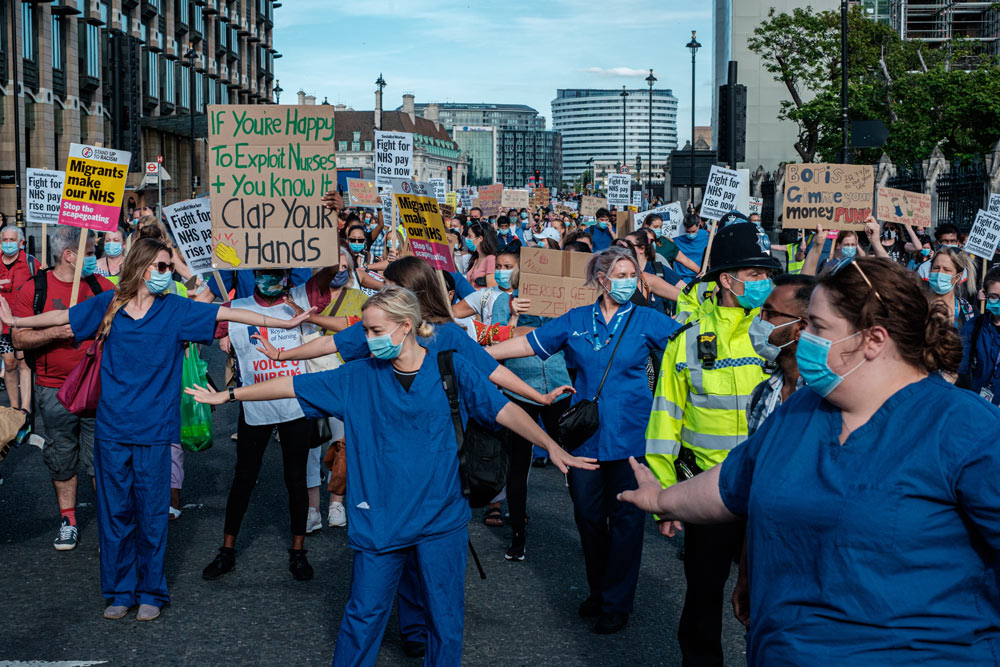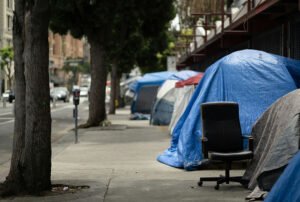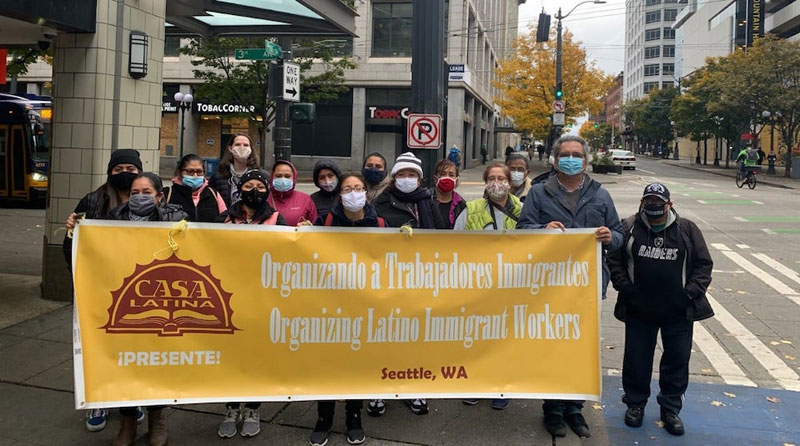
The media called it “Striketober.” After years—decades really—of the media ignoring labor unions almost completely—union strikes were headline news. Academics, healthcare workers, and steelworkers alike all prepared to walk off the job that month in order to demand fair treatment or to protest terrible terms of employment.
During October, over 100,000 unionized workers in the private sector were poised to strike or already walking picket lines to improve their wages and working conditions. This included the first strike at John Deere in decades, where 10,000 United Auto Worker (UAW) members joined picket lines. Other workers going on strike that month included coal miners in Alabama, telecommunications employees in California, and hospital workers in New York.
In some cases, displays of worker resolve made striking unnecessary. A nationwide strike was authorized by the 60,000 members of the International Alliance of Theatrical Stage Employees (IATSE). The vote in favor was 99 percent. Even more significant, 90 percent of all union members voted in that strike authorization vote. When was the last time you heard of an election with a 90-percent turnout? It would have been the first strike in the union’s history. The final offer accepted by the union was a victory for the workers—but also less than what roughly half of IATSE voters wanted—actually, fewer than half who voted approved of the contract, but it passed because of the union’s “electoral college”-style voting system. IATSE, in short, speaks to both the rise of a new generation of worker activists and to ongoing challenges unions face due to both internal bureaucratization and external (both corporate and government) oppression.
Others strikes are ongoing, such as the work stoppage by 40 cement factory workers in Pennsylvania who are holding the line for raises over 25 cents and a dental plan. There are also 1,400 workers on the line at Kellogg in Battle Creek, Michigan. Earlier this month, too, in Buffalo, New York, workers won their first unionization vote at a local store of the coffee chain Starbucks.
This newsworthy burst of resistance has made people question whether the rise in worker militancy will have staying power. While the strikes signal an exciting time for labor unions, they are far less extensive than in the middle third of the 20th century. The years following the Second World War witnessed some of the largest strikes in US labor history, after companies that raked in wartime profits refused to reward workers with raises, return to reasonable hours, or restore normal benefits, provoking mass frustration and organized refusal. Almost five million workers across industries—about four percent of the total US population at the time—participated in a wave of work stoppages to protest these poor wages and perilous conditions, making up around 10 percent of the national workforce. In the two decades following, pay rose at the same rate as productivity; as the US became wealthier, its middle class was born.
Yet it was at this moment of peak union strength that political and economic forces combined to tamp down and contain the strength of the labor movement. The immediate response to the mid-century strike wave was political assault: the federal government passed laws such as the 1947 Taft-Hartley Act to prohibit actions such as sympathy strikes, to authorize states to pass “right-to-work” laws, and to restrict the tools that unions might use to oppose outsourcing. Anti-union amendments to the National Labor Relations Act (NLRA) emboldened employers, already favored by labor law, to exploit their advantage and weaken unions by any means necessary.
During the long arc of the 20th century, management put together a reliable playbook, including replacing striking workers—a threat facing those Kellogg workers in Michigan, for instance, right now—holding mandatory anti-union meetings, delaying contract negotiations, locking out employees, and even firing union activists—to oppose unionization efforts and chip away at existing unions. As employers consolidated power and labor law did little to defend workers, the percentage of workers who were part of unions began to decline. By the 1980s, these political assaults increased as more and more companies moved production facilities outside the United States. Union leaders began accepting contracts that could do little to protect workers from closures and cuts.
Sign up for our free newsletters
Subscribe to NPQ's newsletters to have our top stories delivered directly to your inbox.
By signing up, you agree to our privacy policy and terms of use, and to receive messages from NPQ and our partners.
Today, critics argue that low union density—back in 1945, 35.4 percent of private sector workers were members of unions in the US compared to 6.3 percent today—and declining strike frequency resulting from these decades of defeat prove that the labor movement is an unlikely vehicle for political change. Some even contend that the current strike wave isn’t really a wave at all.
But strikes hardly account for all the strands of political activity that make up the labor movement. Take the fact that a record 4.4 million people quit their jobs in September— and 39 million have done so this year. Workers from agriculture to hospitality stayed productive through a pandemic—yet have not received raises commensurate with skyrocketing profits. Low-wage workers lacked sick leave and health insurance even as they were forced back to work. Grievances go beyond wages to working conditions—including overtime, abuse, sick leave, and staffing. Working people everywhere, organized or not, seem to be ready to both refuse bad work and demand better.
Issues around work are also, of course, attracting media attention, a reflection of the fact that work and workplace injustice occupy the popular imagination. Almost every person in the country had to make changes to their lives during the pandemic, and these changes were often dictated or delimited in part by their jobs. For some, this meant remote work or temporary furlough, but for others this meant continuing to work despite constant risk of exposure to COVID-19 or despite the lack of appropriate social infrastructure that makes work possible, like schools and childcare. Combined with increased awareness about extreme inequality and the upward transfer of wealth, it’s not surprising that 68 percent of Americans tell Gallup that they approve of unions, the highest level since 1965. The scope of political possibility and the optimism of mass movements, recently widened in the wake of the Black Lives Matter movement, includes the workplace again.
Energy around the labor movement has meant that some unions are experiencing internal revivals, which could make them stronger. Recent rank-and-file efforts within some of the oldest unions—such as the International Brotherhood of Teamsters and the UAW—are attempting to rework inert bureaucratic structures and to take control of the unions’ directions. The new leadership of the Teamsters, a 1.3 million member union, stated that their immediate goals are to win their members better contracts, abolish two-tier wage systems, organize Amazon and other major corporate employers, and put pressure on unsupportive politicians. They plan to rework their organizing structure so that leaders emerge from the membership—and have also promised to reform majority vote requirements that make it harder for locals to turn down bad contracts.
Within the UAW, the recent “One Member, One Vote” referendum, which would remove the current delegate structure and give all 400,000 active members the ability to vote to elect its executive board, passed with a majority vote. Reforming the union’s elections structure to direct elections will result in new leadership unaffiliated with the union’s current executives—some of whom have been found guilty of corruption—and will allow members to collectively push for other organizing priorities. This is an important point. Union democracy is not just a “nice to have” but often a “must have” to enable these institutions to realize workers’ visions of empowerment and workplace democracy. Commitments to democracy within unions as institutions is a sign that labor could be experiencing something like a political revival. And there is little reason to believe that the UAW will be the last union to be compelled to reorganize its governance structures in the wake of the new wave of worker activism and militancy.
Political activity within unions is, in fact, a necessary component for progressive social change. Real pressure from a mass movement is what it will take to pass legislation to protect workers, such as the PRO Act, a set of much-needed labor laws that would end right-to-work laws nationwide, close loopholes that allow corporations to exploit workers, and introduce real penalties for employers that violate labor law. It would also put a stop to repressive practices by employers that thwart unionization and collective bargaining. The PRO Act has already passed in the US House of Representatives but has been blocked by Republican opposition in the US Senate. It will require incredible amounts of pressure on politicians and massive organized struggle to enact it, although it is a real chance for the government to protect the working class after several decades of brutal inequality and economic crisis.
Striketober—now a whole strike season—has been a galvanizing moment because of its political promise. It is the flashpoint of a movement, led by workers demanding change, to resist the degradation of life within and beyond the workplace. The struggle began before this October and will continue long afterward, but this moment will remain significant for its reigniting of the spirit of resistance. But the labor movement cannot be sustained without large-scale structures that can fight for change. Next year, one hopes, will see not just more strikes, but also more unions.












